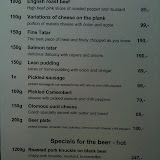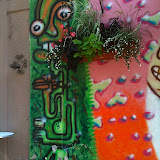Monday, 27 July
We arrived in Poland with some anticipation: for Kevin, he is in the land of his wife’s ancestors; for me, the ancestral land of most of my family before the wars. It is strange to “come back” to a place with such a mixed and difficult history, a country that never gave up the struggle against the Nazis and yet a place where some of the worst atrocities occurred. I feel little connection to this country, though, probably because my grandparents never considered themselves Polish; their identity was strictly Jewish, an attitude common where the Jews were forcibly separated, going back to the middle ages. Despite the anti-Semitism and wartime atrocities, though, my Bubby used to speak positively of her childhood in Bialystok, the youth meetings they had in the forest, and the Polish friends who hid her and her family from the pogroms. When I look into the faces of the old people here, the ones who may have lived through that time, I think of such complexities of history and humanity.
We arrived in the evening and found ourselves comfortably ensconced at the HP Park Plaza Hotel, with casino attached, a lovely place overlooking the river, with its little bridges and islands, and the spires and squares of the old town across the water. In the morning, we met with Marek Oziewicz, who kindly brought with him Majka Tarnogórska, a philologist and expert, of all the most unlikely and ombliferous of things, on Polish literary nonsense for adults. She is currently working on a book about Polish limericks, but her initiation into the Grand Art happened three years ago, when she decided to dedicate her life to scholarship in nonsense. After picking up our collective jaws from the floor, Kevin and I listened intently as Marek and Majka sifted through the nonsense scene of Poland and Wroclaw (pronounced “Vrots-wov,” of course). Majka provided a comprehensive bibliography of many kinds of Polish nonsense, including some of the most exalted Polish poets who also, by no accident, were nonsense writers, including Barańczak, Tuwim, Gałczyński, and Słonimski. We learned that the political situation in Poland, a country that has been under one occupation or another for hundreds of years, necessitated the development of nonsense art, a kind of subversion that is almost impossible to confront or quell. We also learned of the “Orange Alternative” a movement of dwarves against Communism. Yes, that’s right, because people were not allowed to congregate for any kind of organized political activity, members of this group dressed as dwarves, held dwarf meetings and dwarf protests, advocating dwarf rights and the freedom of universal dwarfdom. It was not uncommon in the late 1980s for these dwarves to be seen, pointed hats flopping in the breeze, as they ran away from the police. Today, as one walks the cobbled streets of Wroclaw, the dwarves appear everywhere, as little statues on top of mailboxes, hiding on window ledges, simultaneously pushing and pulling a large metal globe. Here are two particularly disreputable dwarves :

Here, one of the dwarves participates in graffiti subversion.

It is a city steeped in a carnivalesque tradition of nonsense resistance.
One of the new aspects of nonsense that Majka introduced us to was the Polish proliferation of new nonsense genres. That is, many Polish writers were not only creating nonsense, but also inventing new sub-genres. For example, the “Gulliver limerick” is a limerick that deals with only a very small point. She said that once these genres of nonsense were created, other writers of nonsense took them up and wrote within them. Edward Lear, with his nonsense alphabets, recipes, ballads, botany, and limericks, was perhaps the greatest English example of such creation of nonsense types, but it has been extremely rare since then.
After lunch, we went with Majka to several local bookstores, where she helped us buy some of the most important Polish texts. Bookstore browsing is an exhausting and throat-parching activity, so we tipped our elbows at perhaps the oldest restaurant in Europe, in the town square. She was then extremely kind enough to invite us back to her apartment, to see her nonsense library and continue the elbow-tipping on what we were promised was her nonsensical balcony. We walked about 25 minutes, stopping at some shops to pick up food and beer, and landed at her lovely, airy apartment overlooking a courtyard filled with flowers and a small river nearby. We spent the rest of the evening, and into the night, going through her library, talking nonsense in its most sublime and lugumbrious aspects, and writing the following pieces “exquisite corpse”-style, each of us writing alternative lines.
Balcony Types
With sparrows and umbrellas down,
You will attack the nasty town.
They may defend with crows and crabs.
And now, my guys, we stop surprised
At all the weapons n’er surmised:
The blunder-boost! The flinging pies!
The screaming wasps and sacri-flies
Of first-born frogs, flung in abandon
“Be careful, guys, of what you stand in.”
Fastidious maid lies in the sun,
The maid makes lace for battles to come.
With sparrows and umbrellas down,
We stay in the walking gown,
We pace, we splay, we join the fray,
We justify the First of May.
and the following limerick:
There was an old man of Niger
Who encountered a nine-legged spidger.
He told it a story
About an Aunt in the lorry
That loquacious old man of Niger.
Majka is a true kindred nonsense spirit, and our connection will surely continue into the mists of the fuliginous and misty-fisty future.

PS. I wonder if nonsense poetry written by a Pole, a person of Polish ancestry, and a man married to a Pole can be included in the Polish section of the anthology…? Vote on it in the survey, in the left-hand panel!















































